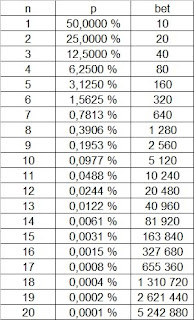Picture author: Conor Ogle, source: Wikipedia
So, if you start with $10 you will eventually win $10 and get your bets back. The strategy is flawed to begin with, but this one of the reasons casinos use zero and double zero in addition to capping the maximum bet. Given that you would have 50/50 chance and very large amount of money to use for betting, you would beat the casino every time. And that's not OK for casinos.
But let's assume for a while that there would be a casino with roulette which has no zeros and no cap for maximum bet. I.e. betting on black/red would really be a 50/50 chance. This would be then equal to coin tossing (head or tails), which is typically used as an example in many books on probability.
The biggest flaw in the martingale strategy even in case of 50/50 chance winning is that it requires very large amounts of money to get even a small win. Let's assume you want to win $10. The table below gives you the probability (p) of loosing "n" bets in a row. It also shows what bets you need to place using the strategy.
Even though it is very rare (1 in million) to see 20 heads (or 20 black) in a row, it is not impossible. In fact, in the roulette book, the writer said that he had witnessed a streak of over 20 of the same color. Assuming that you would win on the 20th bet, you would still need some 5,2 million dollars to claim your 10 dollar victory.
To make odds better, the writer introduced a "system of five". Meaning that you wait until there has been eg. five times black and then you start applying martingale using red. Unfortunately, this strategy does not increase you chances of winning at all. Even if you would wait until 10, 15 or 20 of the same, you chances would not increase.
You still would have chance of 50% in loosing the next bet and the table above does not change one bit from that point forward. I believe it is a very common error to think if you see someone get 10 times heads in coin tossing, the probabiliy of next heads is low. The probability of seeing 10 heads in the row is 9,77% (i.e. low), but in case that is already in the past then it won't matter. The next toss carries 50%/50% probability for tails/heads in the same way that every single toss does.
Similarly I believe that technical analysis does not give significant advantage, because what has happened in the past won't matter now or in the future. You might get lucky and it works for awhile, but eventually you will loose if that is the only strategy you have. Naturally, technical analysis can be used as a tool among others to determine what is going on in the market. I.e. understanding what has happened until now.
Basically the casinos and the online brokers have the same design. The more you play, the more you will loose to the "bank". Therefore, it is no wonder that many brokers and the like advocate technical analysis. The more trades there are the more money they will make. People implementing true buy and hold strategy are lousy customers for brokers.
Still, if you want to gamble with your money, it is much more wise to gamble in stock markets than to do so in a casino. Because your odds are much much better and you can limit your losses more easily.


Thank you very much for this interesting report. I am coming from Germany and teaching since 1999 the people about chances, risks and advantage roulette play. My free ebook with tips and tricks is very popular and a great help for starters.
ReplyDeleteOne main topic of my articles is also the martingale. The problem is, there is a huge difference between theory and reality. The house edge of 2,7% only exists on the paper. In real sessions players are facing tremendous deviations from the standard. They are simply not losing 2,7% of their wagers (in Austria and online Casinos there is no longer an advantage on even chances with Zero). They are losing it all.
Even series on the simple chances can be go longe than 20. I have seen several of them in my life. As you said, there is no point, when Martingale will work, because also after waiting for 20 times black the odds are equal for the next spin.
But one thing makes progressions like this more worst. It's the appearance of Zero. One single Zero can destroy the complete bankroll even if the right color is coming. I wrote a long article about this ( http://www.dertrend.com/roulette.php ). You might use the Google translator. What is important are the two graphics, when you scroll down. The 2nd graphic with spins demonstrates the impact of Zero and how every Zero shortens the survival of the Martingale system.
When two unlucky Zero are falling, then the player lost also two very important survival stages of his progression. The ball then not need to produce e.g. 11 times red but only 9 times in a row to burst the bubble.
This is the most underestimated danger when playing this kind of roulette system.
You are right. Money management is the key, and also in the queen of games there are possibilities to improve the savings of the bankroll.
I wish everyone nice wins, but never forget, it's not that easy as some suggest it.